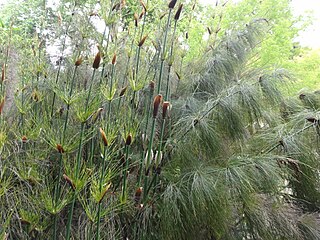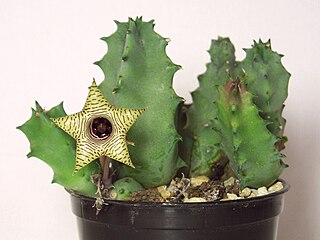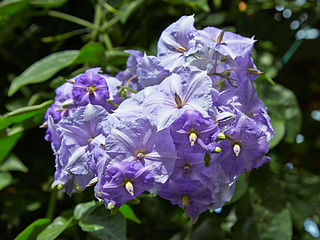
The Royal Horticultural Society (RHS), founded in 1804 as the Horticultural Society of London, is the UK's leading gardening charity.

Erica arborea, the tree heath or tree heather, is a species of flowering plant (angiosperms) in the heather family Ericaceae, native to the Mediterranean Basin and Ethiopia, Kenya and Tanzania in East Africa. It is also cultivated as an ornamental.

Pelargonium is a genus of flowering plants that includes about 280 species of perennials, succulents, and shrubs, commonly called geraniums, pelargoniums, or storksbills. Geranium is also the botanical name and common name of a separate genus of related plants, also known as cranesbills. Both genera belong to the family Geraniaceae. Carl Linnaeus originally included all the species in one genus, Geranium, and they were later separated into two genera by Charles Louis L'Héritier de Brutelle in 1789.

Grevillea, commonly known as spider flowers, is a genus of about 360 species of evergreen flowering plants in the family Proteaceae. Plants in the genus Grevillea are shrubs, rarely trees, with the leaves arranged alternately along the branches, the flowers zygomorphic, arranged in racemes at the ends of branchlets, and the fruit a follicle that splits down one side only, releasing one or two seeds.

Crocosmia (;), also known as montbretia, is a small genus of flowering plants in the iris family, Iridaceae. It is native to the grasslands of southern and eastern Africa, ranging from South Africa to Sudan. One species is endemic to Madagascar.

Spartium junceum, known as Spanish broom, rush broom, or weaver's broom, it is a species of flowering plant in the family Fabaceae and the sole species in the genus Spartium. It is closely related to the other brooms.

Stapelia gigantea is a species of flowering plant in the genus Stapelia of the family Apocynaceae. Common names include Zulu giant, carrion plant and toad plant. The plant is native to the desert regions of South Africa to Tanzania.

Allium giganteum, common name giant onion, is an Asian species of onion, native to central and southwestern Asia but cultivated in many countries as a flowering garden plant. It is the tallest species of Allium in common cultivation, growing to 1.5 metres (4.9 ft).

Crocosmia × crocosmiiflora, montbretia, is a garden hybrid of C. aurea and C. pottsii, first bred in 1880 in France by Victor Lemoine. The basionym of the hybrid is Montbretia crocosmiiflora Lemoine. In 1932 it was reclassified as C. × crocosmiiflora (Lemoine) N .E.Br., but the common name "montbretia" is still often found in horticultural literature, and is commonly used in the British Isles for orange-flowered cultivars that have naturalised, while "crocosmia" is reserved for less aggressive red-flowered cultivars.

Melianthus major, the giant honey flower or kruidjie-roer-my-nie, is a species of flowering plant in the family Francoaceae. It is an evergreen suckering shrub, endemic to South Africa and naturalised in India, Australia and New Zealand. It grows to 2–3 m (7–10 ft) tall by 1–3 m (3–10 ft) wide, with pinnate blue-green leaves 30–50 cm (12–20 in) long, which have a distinctive musky odour. Dark red, nectar-laden flower spikes, 30–80 cm (12–31 in) in length, appear in spring, followed by green pods. All parts of the plants are poisonous.

Crocosmia aurea, common names falling stars, Valentine flower, or montbretia, is a perennial flowering plant belonging to the family Iridaceae.
Peter Goldblatt is a South African botanist, working principally in the United States.

Elegia capensis, called the horsetail restio, is a species of grass‑like flowering plant in the genus Elegia, native to the Cape Provinces of South Africa. It has gained the Royal Horticultural Society's Award of Garden Merit.

Euphorbia meloformis, called the melon spurge, is a species of flowering plant in the genus Euphorbia, native to the Cape Provinces of South Africa. A succulent, it has gained the Royal Horticultural Society's Award of Garden Merit.

Clerodendrum chinense, called the glory bower, is a species of flowering plant in the genus Clerodendrum. It is native to Nepal, the eastern Himalayas, Assam, the Andaman and Nicobar Islands, south-central and southeast China, Southeast Asia, and Malesia. It is a perennial shrub that grows up to 3 m (10 ft) tall.

Huernia thuretii is a species of flowering plant in the family Apocynaceae, native to Namibia and to the Cape Provinces of South Africa. A succulent, as Huernia thurettii it has gained the Royal Horticultural Society's Award of Garden Merit.

Dimorphotheca jucunda, the delightful African daisy, is a species of flowering plant in the family Asteraceae. It is native to South Africa, Lesotho and Eswatini, and introduced to Ireland and Tasmania. As its synonym Osteospermum jucundum, it and two of its cultivars, 'Blackthorn Seedling' and 'Langtrees' have gained the Royal Horticultural Society's Award of Garden Merit.

Solanum wendlandii, the giant potato creeper, potato vine, Costa Rican nightshade, divorce vine, or paradise flower, is a species of flowering plant in the family Solanaceae. It is native to Mexico, Central America, and northwest South America, and has been widely introduced as an ornamental to other tropical locales, including the Caribbean, Africa, Nepal, Java, and many islands in the Indian and Pacific Oceans. A robust vine reaching 15 ft (4.6 m), its long-lasting dark purple flowers eventually fade to white.

Crocosmia pottsii, Potts' montbretia, is a species of flowering plant in the family Iridaceae, native to KwaZulu-Natal and the southern Cape Provinces of South Africa, and introduced in Colombia. With Crocosmia aurea it is a parent of the widely cultivated Crocosmia × crocosmiiflora.

















